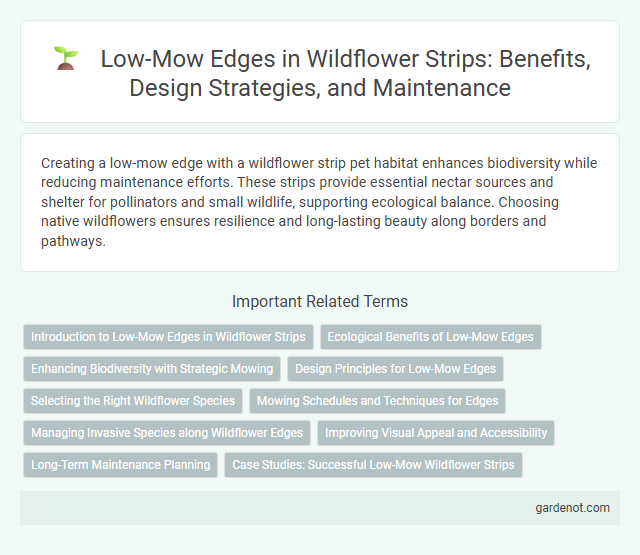Creating a low-mow edge with a wildflower strip pet habitat enhances biodiversity while reducing maintenance efforts. These strips provide essential nectar sources and shelter for pollinators and small wildlife, supporting ecological balance. Choosing native wildflowers ensures resilience and long-lasting beauty along borders and pathways.
Introduction to Low-Mow Edges in Wildflower Strips
Low-mow edges in wildflower strips create transitional zones that support biodiversity by providing habitat for pollinators and beneficial insects. These edges reduce maintenance needs by allowing native grasses and wildflowers to flourish with minimal mowing, enhancing ecological resilience. Incorporating low-mow edges improves soil health, promotes seed dispersal, and strengthens the overall ecosystem function within wildflower strips.
Ecological Benefits of Low-Mow Edges
Low-mow edges enhance biodiversity by providing habitat for pollinators, birds, and beneficial insects crucial to ecosystem health. These edges improve soil quality and water retention by reducing disturbances and promoting deep root growth. Maintaining low-mow strips reduces carbon emissions compared to frequent mowing, supporting climate change mitigation efforts.
Enhancing Biodiversity with Strategic Mowing
Strategic mowing of low-mow edges in wildflower strips promotes habitat diversity, supporting pollinators and beneficial insects crucial for ecosystem balance. Maintaining a reduced mowing frequency allows native wildflowers to thrive, increasing floral variety and seed production. This approach enhances biodiversity by creating continuous floral resources and shelter throughout growing seasons.
Design Principles for Low-Mow Edges
Low-mow edges support biodiversity by creating gradual transitions between mowed lawns and wildflower strips, reducing habitat disturbance for pollinators and beneficial insects. Using native wildflower species and maintaining varied plant heights enhances ecological connectivity and soil health along these edges. Strategic placement of low-mow zones optimizes visual appeal while promoting sustainable landscape management practices.
Selecting the Right Wildflower Species
Selecting the right wildflower species for a low-mow edge enhances biodiversity while maintaining manageable maintenance. Native wildflowers such as Echinacea purpurea, Rudbeckia hirta, and Asclepias tuberosa thrive in low-mow habitats and provide essential resources for pollinators. Choosing species adapted to local soil and climate conditions improves establishment success and supports long-term ecological benefits.
Mowing Schedules and Techniques for Edges
Low-mow edges in wildflower strips require precise mowing schedules to balance plant health and habitat preservation. Mowing once or twice annually, ideally post-flowering and seed set, minimizes damage to native species while controlling invasive grasses. Utilizing specialized mowers with adjustable blades ensures clean cuts close to the edge without disturbing delicate wildflowers or soil structures.
Managing Invasive Species along Wildflower Edges
Managing invasive species along wildflower strips requires maintaining a low-mow edge to minimize disturbance and promote native plant establishment. Regular monitoring and selective removal of invasive plants prevent their spread, enhancing biodiversity and ecological balance. Establishing a buffer of native grasses along the edge further suppresses invasives and supports pollinator habitats.
Improving Visual Appeal and Accessibility
A low-mow edge in wildflower strips enhances visual appeal by creating a clean, defined boundary that contrasts with the natural, colorful blooms. This maintenance strategy improves accessibility for walkers and gardeners by reducing overgrowth near paths while preserving habitat quality. Strategic mowing height and frequency encourage plant diversity and promote a seamless transition between cultivated and wild areas.
Long-Term Maintenance Planning
Establishing a low-mow edge along a wildflower strip reduces frequent mowing and promotes habitat stability, supporting pollinators and native wildlife. Implementing a long-term maintenance plan that includes annual inspections, selective weeding, and strategic mowing intervals ensures the strip remains healthy and resilient. Proper planning minimizes invasive species encroachment and sustains floral diversity, enhancing ecological benefits over time.
Case Studies: Successful Low-Mow Wildflower Strips
Case studies of successful low-mow wildflower strips demonstrate significant ecological benefits such as increased pollinator diversity and improved soil health. For example, the Xerces Society's project in Iowa reported a 40% rise in native bee populations within the first two years of implementation. These low-mow strips also reduce maintenance costs by up to 50%, offering sustainable habitat solutions in agricultural landscapes.
Low-mow edge Infographic

 gardenot.com
gardenot.com